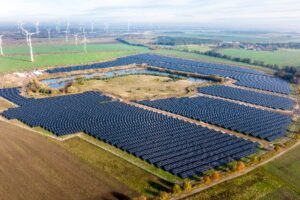The Next Step For Solar?

In their attempt to make solar cells more efficient, scientists are trying today different materials that can successfully replace silicon in terms of efficiency and price.
Perovskites represent a group of synthetic materials defined by their crystallographic structure.
Being materials that can be easily used to coat different surfaces, perovskites can also be used to create solar cells.
This way, they are used to build solar panels that consist entirely of solar cells made of perovskites, but they can also work in tandem with other technologies like classic solar cells made of silicon.
Perovskites And The Blue Spectrum Of Light
Perovskite semiconductors used in cells can convert the blue spectrum of light into electricity with an efficiency of 25 percent (single-junction perovskite cells).
The blue spectrum of light uses shorter waves (wavelengths between 450 and 495 nanometers). The red light spectrum of light uses longer waves, (wavelengths between 620 and 750 nm). However, the blue spectrum of light has a higher frequency and carries more energy compared to the red spectrum of light, and this way, solar cells made of perovskites are slightly more efficient.
When used in tandem with solar cells made of silicon, the efficiency grows up to 30 percent.
Perovskites could represent the next step in solar technology because they are cheaper to produce, slightly more efficient, and being thin and lightweight enough, they can be used to coat almost everything.
There have already been several attempts to introduce them to the market, but due to several logistical hurdles, they didn’t manage to replace silicon cells yet.
Perovskite Solar Cells Are Quite Fragile
The biggest hurdles of perovskites refers to their durability factor. Solar cells made of perovskites, are thin and light, but at the same time, they are also quite fragile, which is not great for a material that must withstand sun, rain, hail, frost, etc.
The samples tested were so fragile that they used to break before researchers could even make it across the lab to be tested. If samples cannot be handled in the lab, they cannot withstand a hailstorm or stronger winds torsion specific to solar panel frames installed in the real world.
However, a more recent study (released in April 2022), found that organometallic compounds (ferrocene) could be used as an additive to help improve the lifespan of the solar cells made of perovskites, by keeping the 25 percent efficiency, but improving the stability, durability and lifespan of the cell.
The enhanced cells using the ferrocene additive, maintained 98 percent of the cell’s original conversion efficiency rate (25%) after 11,500 hours of use.
At the same time, the ferrocene based perovskite cells passed the damp heat stability tests with flying colors.
Perovskite’s Infamous Photodegradation Problem
This year (2022), researchers have dived into why perovskites work like this, to find out both the good and the bad.
In May 2022, scientists at the Cambridge University and Japan’s Okinawa Institute of Technology (OIST), used imaging techniques to observe the structure of perovskite films at the nanoscale. They found out what happens in the moment when the light hits the film. They found out that nanoscopic trap clusters are behind perovskite’s infamous photodegradation problem.
The nanoscopic trap clusters are defects in the material that show up as pockets from the cell processing, which ultimately make the film less effective and structurally fragile.
However, scientist found out that there is a way to overcome these issues. The carrier traps must be removed during the manufacturing process through careful tuning of the structural and chemical design of the cells.
Making these tweaks large-scale-friendly, we have the recipe for producing more of these films while making them more competitive in the performance department.
To increase the generation capacity for solar energy on the planet, we have to make the technology more efficient and more affordable compared to the current technology using silicon solar cells.
Conclusion
Perovskite solar cells represent a modern technology in the field, because we can use them to create solar cells that are 10 percent more efficient, more affordable, and also more versatile.
In general, perovskite’s can easily coat surfaces, and this means that being lighter and more practical, they can successfully replace conventional solar panels based on silicon solar cells.
If we can use a technology that is cheaper, lighter, and slightly more efficient than conventional solar modules, why not use it?




